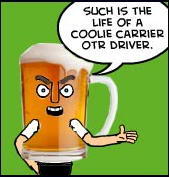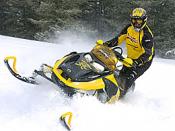 |
|

11-23-2008, 06:32 PM
|

Senior Board Member
Join Date: Mar 2006
Location: San Diego, CA
Posts: 1,190
Mentioned: 0 Post(s)
Tagged: 0 Thread(s)
|
Quote:
Originally Posted by Snowman7

OK I'll start. Don't run your defroster when its snowing. The hot air on the windshield melts the snow but the cold air outside refreezes it to your wipers which is why they get caked with ice and won't work. Run the heat thru the floor and your windows should stay clear and your wipers won't freeze.:thumbsup:
|
I never knew that..........great tip. I tried to give a + comment, but I have to spread it around more.
__________________

|


11-23-2008, 07:05 PM
|

Board Icon
Join Date: Oct 2005
Location: the 19th hole / NC
Posts: 9,647
Mentioned: 0 Post(s)
Tagged: 0 Thread(s)
Mentioned: 0 Post(s)
Tagged: 0 Thread(s)
|

YankeeTURBO said:
Quote:
|
When the roads get bad, you may have to use the diff. lock to get going. Once your speed is up to between 5 and 10 mph, UNLOCK THEM. The "4-WHEEL-DRIVE" theory is fine for a 4-wheeler, but doesn't work as well with a combination vehicle.
|
I hate to disagree with Turbo, as I'm sure he has more experience than I, but my OWN experience has me doing just that. When conditions warrant locking my diffs, I keep them locked. When the weight in your box is pushing against your drives, I want that force to be countered by traction on ALL drive tires, not just one or two. Force distributed over a larger area of rubber and road. Ice can be "spotty." What he says about breaking loose ALL drives may be true, but feathering the pedal is meant to avoid that. It is not the "action" that I fear and contemplate, but the "reaction." The very reason that starting off with them locked works is that the torque is distributed over a larger area of contact. This theory should also apply to "resisting" the outside force of trailer weight and centrifugal force rounding curves.
Try "hill climbing" in a two wheel drive vehicle vs. a 4 wheel drive. No matter how much momentum you have, you will never make it to the top without applying torque to EVERY drive wheel you have. I fail to see how the theory of all wheel drive would apply to 4wheelers but not combination vehicles.
Quote:
|
Ask Golfhobo about his run across I-40 to Amarillo, in December, a few years ago. I don't know what he was carrying, but I had a very light load, and there were drivers chaining up to run flat land. (I didn't have any trouble at all.)
|
Yes, I was in that "battle." Trucks and 4wheelers were wrecked everywhere! (most of the trucks were single screw.) I was approaching Amarillo from the East. The roads were slick, but not completely iced over. There were places where the pavement shone through, and I wanted SOME drive tire to have traction on those spots. I locked my diffs at the OK line, and kept them locked, going about 40-45 mph, and passing everyone. Some might say that was too fast, but I was continually "testing" to see if it was safe. (more later.) For the record, I was heavy. 44k lbs of .... you guessed it.... BEER! :lol2:
Quote:
|
No sudden moves with the throttle, wheel, or the brakes.
|
On the surface, this sounds right. But again.... I do things differently. 99% of the time, I would drive with this in mind. However.... I "test" my traction by doing JUST this. If I have any question as to whether I am "tracking" or "gliding," I will make a quick but LIMITED jerk of the wheel to see if my steers are steering or just playing along. If the truck wobbles a little, I am in control. If it doesn't react, I am over the edge, and I slow down. Same with the throtte. Most of the time, I am "feathering" it like Turbo says.... forcing the engine to be either pulling gently, or decelerating gently. But, if I am not sure of my contact with the road, I will make a quick but LIMITED jab at the throttle. If I can "feel" the truck trying to respond, I'm in control. If it seems more like the engine is "racing," I am over the edge, and slow down. I also like to know if I have the ability to stop the truck if I need to. To "test" this, without risking breaking traction on my drives, and ONLY on a straight stretch of road, I will quickly "jab" my trolley bar. If the the tandems have enough traction, the truck will immediately slow down a bit. All of this is part of MY "Smith System." I want to know the level of my control at all times.
Quote:
|
There's always a lot of talk about "BLACK ICE". I was once told that what makes black ice so bad is the fact that you can not tell if it's road surface or ice on top.
|
A quick but LIMITED jerk of my steering wheel, when I am expecting it and ready for it, will tell me this.
Quote:
|
And, choose a higher gear to reduce the torque of the engine and reduce your chances of breaking the drives loose.
|
And diffusing that torque over a larger area (all drive tires) will do this, too.
Quote:
|
And, being from MN, I'm sure you are also aware (and many other drivers are not) that the closer to freezing the temp is, the more slick the snow cover can be. If you can pack a snowball, expect the snow covered road to be very slick. Also, under trees and overpasses, look for ice. Any area where the sunlight is blocked.
|
It's not JUST the temperature. It is also the moisture IN the snow (which is determined thousands of feet up in the sky.) Western snow is usually much "dryer" than Eastern snow. Know the humidity levels where you are driving. If the snow is blowing and/or drifting across the roadway, it is obviously much dryer than snow that lands and just lays there. 
Dry snow requires "packing" to make it icy. Wet snow will ice up due to "freezing" the moisture contained therein. I would rather drive in a foot of Western snow than an inch of Eastern snow.
What someone said about paying attention to weather forecasts is right on! KNOW what you will find ahead of you. And KNOW whether it started as freezing rain or as a dry snow.
One more thing. The Western and Northern slopes of any mountain is MORE LIKELY to have a lower temperature and therefore an unexpected snow. Just because you climbed UP a mountain in dry weather OR rain, does not mean that is what you will find once you crest the mountain! Anyone who has ever gone through the Eisenhower Tunnel going west from Denver knows exactly what I mean.
__________________
Remember... friends are few and far between.
TRUCKIN' AIN'T FOR WUSSES!!!
"I am willing to admit that I was wrong." The Rev.
|

11-23-2008, 07:17 PM
|

Board Regular
Join Date: Sep 2006
Location: Columbus, OH
Posts: 460
Mentioned: 0 Post(s)
Tagged: 0 Thread(s)
Mentioned: 0 Post(s)
Tagged: 0 Thread(s)
Mentioned: 0 Post(s)
Tagged: 0 Thread(s)
|

Quote:
|
Like I said a wheel with torque will spin b4 a wheel without...now a drive wheel will break loose when you put more twist to it than you have traction which is hader to do with 2 live axles than 1 since the torque is now applied to 2 drive wheels not 1 , But if you use 2 much skinny pedal you are now breaking loose 2 tires not 1...and 4 if you have a locking differential ...NON OPEN CARRIER...as both drive shafts will receive equal torque regardless of what wheel has most traction unlike open where the wheel with the least traction get the torque ,as energy always follows the path of least resistance ... So if you srew up with diffs locked it's worse b/c you break loose more rubber,and if you spin a tire loose it loses traction in every direction so you will slide to the down hill side of the road ,because it's the path with least resistance...Until you find a few large trees .
|
This is a really, really big myth. People see one wheel spinning on an axle during slippery conditions, and people assume all of the torque is ONLY going to one wheel...this is false. Has to do with friction. There are two relevent coefficients of friction for an object, which are static and sliding. Static means the object is NOT sliding, sliding means...well...you get it. The static coefficient is ALWAYS greater than sliding...always will be. This is why your truck will stop faster if all wheels are braking heavily but ARE STILL ROLLING than a truck that locks up all 18.
The simple truth is, an open differential sends EXACTLY EQUAL torque to both ends. This applies both if it's a differential within an axle, OR a differential BETWEEN two axles, aka inter-axle differential. When one wheel breaks traction and starts spinning, it is gripping the ground LESS than the other wheel(s) that is gripping. This means that it is now handling less torque, which in turn causes a torque reduction on the other side, which is why you almost never spin both wheel sets on an axle. any attempt to feed more power yields no gain, since attempting to increase torque only spins the spinning wheel faster, while not putting any MORE torque or power to the wheel that is not sliding.
The same concept applies to an inter-axle differential. Same device, same effect, just a different application. This time, when the inter-axle is NOT locked, it acts as an open differential between the axles. Meaning if one wheel spins up on one axle, it will also limit the torque going to the OTHER axle, which means in practical terms, that one wheel will likely be the only one spinning. The APPLIED TORQUE is the SAME across all wheels, however since 3 are now gripping and can handle more, the one that CAN'T handle more, the spinning one, is the one limiting everything.
All of this changes when you lock the inter-axle diff. This allows one axle to recieve MORE torque than another, in the event that a loss of traction occurs. For example, if one of your front wheels breaks traction, FULL POWER can still be applied to the rear axle, UNTIL a wheel set on the rear axle breaks traction, and thus, you end up with TWO spinning wheels. This is why people think that when the diff is locked, you are under TWO WHEEL DRIVE...which isn't the case. Each wheel is still having the EXACT SAME applied torque, and the exact same forward force acting on the truck...but ONLY as much as the slipping wheels!
Windwalker nailed it right on the head, in regards to why you DON'T want the inter-axle diff locked in while moving down the road. When a wheel breaks traction, it can no longer control lateral movement, as the full effect of it's friction on the road has been spent trying to turn the wheel, leaving nothing to keep the rig straight. With the differential unlocked, you will likely have 3 other wheels that AREN'T sliding, and thus have some of their friction availible to keep you on the road. When the diff is locked, and traction is lost, you have AT LEAST two wheels spinning...which puts you at grave risk for a jackknife.
Great post, windwalker...I probably just confused everyone...:lol:

|

11-23-2008, 07:48 PM
|

Local Advocate
Senior Board Member
Join Date: Jul 2004
Location: Speedway Indiana
Posts: 1,751
Mentioned: 0 Post(s)
Tagged: 0 Thread(s)
Mentioned: 0 Post(s)
Tagged: 0 Thread(s)
Mentioned: 0 Post(s)
Tagged: 0 Thread(s)
Mentioned: 0 Post(s)
Tagged: 0 Thread(s)
|
Not at all Tom! Great post! Some valuable and relevant infro from both you and WW. I think it may be time to pass the mantle back..............
As for Golfhobo? What can I say? Some things never change.
__________________
Fuel for free. Pre/Post trip for free. Sit at shipper/receiver for free. "Work 80-100, log 70, get paid for 40." Welcome to OTR coolie carrier truck driving!
|

11-23-2008, 07:56 PM
|

Water Board Administrator
Senior Board Member
Join Date: Feb 2005
Location: the Buckeye
Posts: 1,732
Mentioned: 0 Post(s)
Tagged: 0 Thread(s)
Mentioned: 0 Post(s)
Tagged: 0 Thread(s)
Mentioned: 0 Post(s)
Tagged: 0 Thread(s)
Mentioned: 0 Post(s)
Tagged: 0 Thread(s)
Mentioned: 0 Post(s)
Tagged: 0 Thread(s)
|

Quote:
Originally Posted by TomB985

This is a really, really big myth. People see one wheel spinning on an axle during slippery conditions, and people assume all of the torque is ONLY going to one wheel...this is false. Has to do with friction. There are two relevent coefficients of friction for an object, which are static and sliding. Static means the object is NOT sliding, sliding means...well...you get it. The static coefficient is ALWAYS greater than sliding...always will be. This is why your truck will stop faster if all wheels are braking heavily but ARE STILL ROLLING than a truck that locks up all 18.
The simple truth is, an open differential sends EXACTLY EQUAL torque to both ends. This applies both if it's a differential within an axle, OR a differential BETWEEN two axles, aka inter-axle differential. When one wheel breaks traction and starts spinning, it is gripping the ground LESS than the other wheel(s) that is gripping. This means that it is now handling less torque, which in turn causes a torque reduction on the other side, which is why you almost never spin both wheel sets on an axle. any attempt to feed more power yields no gain, since attempting to increase torque only spins the spinning wheel faster, while not putting any MORE torque or power to the wheel that is not sliding.
The same concept applies to an inter-axle differential. Same device, same effect, just a different application. This time, when the inter-axle is NOT locked, it acts as an open differential between the axles. Meaning if one wheel spins up on one axle, it will also limit the torque going to the OTHER axle, which means in practical terms, that one wheel will likely be the only one spinning. The APPLIED TORQUE is the SAME across all wheels, however since 3 are now gripping and can handle more, the one that CAN'T handle more, the spinning one, is the one limiting everything.
All of this changes when you lock the inter-axle diff. This allows one axle to recieve MORE torque than another, in the event that a loss of traction occurs. For example, if one of your front wheels breaks traction, FULL POWER can still be applied to the rear axle, UNTIL a wheel set on the rear axle breaks traction, and thus, you end up with TWO spinning wheels. This is why people think that when the diff is locked, you are under TWO WHEEL DRIVE...which isn't the case. Each wheel is still having the EXACT SAME applied torque, and the exact same forward force acting on the truck...but ONLY as much as the slipping wheels!
Windwalker nailed it right on the head, in regards to why you DON'T want the inter-axle diff locked in while moving down the road. When a wheel breaks traction, it can no longer control lateral movement, as the full effect of it's friction on the road has been spent trying to turn the wheel, leaving nothing to keep the rig straight. With the differential unlocked, you will likely have 3 other wheels that AREN'T sliding, and thus have some of their friction availible to keep you on the road. When the diff is locked, and traction is lost, you have AT LEAST two wheels spinning...which puts you at grave risk for a jackknife.
Great post, windwalker...I probably just confused everyone...:lol:
|
Good job Tom. According to Hobo we both drive in eastern snow. Which is way worse, kinda like a dry heat!:roll:

|

11-23-2008, 09:28 PM
|

Board Regular
Join Date: Sep 2006
Location: Columbus, OH
Posts: 460
Mentioned: 0 Post(s)
Tagged: 0 Thread(s)
Mentioned: 0 Post(s)
Tagged: 0 Thread(s)
Mentioned: 0 Post(s)
Tagged: 0 Thread(s)
Mentioned: 0 Post(s)
Tagged: 0 Thread(s)
Mentioned: 0 Post(s)
Tagged: 0 Thread(s)
Mentioned: 0 Post(s)
Tagged: 0 Thread(s)
|
Just to clarify, that post was not intended as an affront to BJ...unlike a certain other thread...:whistle:
But it seems like it's almost come to be a commonly accepted principle that only ONE wheel is driving the vehicle at a time...which is far from the truth...and it's much easier to understand how a vehicle's going to react in less than ideal conditions if you understand the dynamics behind it...for those who care! 
On edit: Belpre, sent you a PM...not used to this forum software, didn't realized you replied until yesterday! 
Last edited by TomB985; 11-23-2008 at 09:31 PM.
|

11-23-2008, 09:33 PM
|

Board Icon
Join Date: Oct 2005
Location: the 19th hole / NC
Posts: 9,647
Mentioned: 0 Post(s)
Tagged: 0 Thread(s)
Mentioned: 0 Post(s)
Tagged: 0 Thread(s)
Mentioned: 0 Post(s)
Tagged: 0 Thread(s)
Mentioned: 0 Post(s)
Tagged: 0 Thread(s)
Mentioned: 0 Post(s)
Tagged: 0 Thread(s)
Mentioned: 0 Post(s)
Tagged: 0 Thread(s)
Mentioned: 0 Post(s)
Tagged: 0 Thread(s)
|

Quote:
Originally Posted by belpre122

Not at all Tom! Great post! Some valuable and relevant infro from both you and WW. I think it may be time to pass the mantle back..............
As for Golfhobo? What can I say? Some things never change.
|
You can say you're sorry.
Check these quick videos:
www.youtube.com/watch?v=q-rQTHMVAuw
www.youtube.com/watch?v=y6_kOlUXYoI
then go to this link.
http://www.tpub.com/content/trucktra...283-10_110.htm
But, before you leave it.... check the FIRST paragraph concerning use of the trolley brake to avoid jacknifing. This will vindicate my position in the "debate" with RockyMtnPro many years ago. Also, if you click BACK once or twice, you'll find interesting info on how to use the engine retarder on icy roads. [I am not advocating this. I just found it interesting.]
I am not arguing with Tom. He does sound like he knows what he's talking about, and I have never claimed to... concerning this issue. I do recall that I was taught that there are different types of diff interlocks on trucks. I only know about the ones I've driven.
Also, there may be a disconnect on what type of road conditions we are addressing. A solid sheet of ice may substantiate Tom's position. I am referring to roads with "patches" of ice, or "patches" of pavement, or even "patches" of sand or slag, where ONE tire may lose traction but others might NOT.
There are all kinds of ways to find traction on snow covered roads. ONE is to move to the right and make use of the "growler." I am not driving YOUR truck, or Dobry's. I am driving mine. I have driven in snow for many years of my life. You guys can do whatever makes you feel comfortable. I was only relating MY experience and MY opinion. And unlike many who post here, I have never lost control of my truck, never hit anything, and never asked HOW to drive in snow.
I almost didn't get into this thread, as I don't like telling someone else how to drive their truck. I drive my truck in a manner that I FEEL gives me the most control at the time. I have had 3 "close calls" while driving on slick roads. I came through all 3 with exactly the results I expected by employing the tactics I believed in. One involved running with the diffs locked, and two involved the trolley brake to straighten out my trailer (or to increase braking from the most rearward axle.) But, I am no expert. I'm just a driver. A professional driver, and a SAFE one.
I know (or I think) you were just razzing me, Bel. And, I am NOT responding in anger or indignation. I'm just not using smilies.
I thank Tom for his explanation. Yes, it confused me somewhat. So I went to Wiki for more info. I am still (somewhat) confused. I am not the most mechanical person in the world (but I AM capable of understanding theory.) Probably that low testosterone level that someone accused me of. :lol:
But, I drive by "feeling" the road and my vehicle. And KNOWING the conditions I am in.... or may encounter. And I have every intention and belief that I will retire from trucking accident free. I hope the same for you and all my other "friends" here.
__________________
Remember... friends are few and far between.
TRUCKIN' AIN'T FOR WUSSES!!!
"I am willing to admit that I was wrong." The Rev.
|

11-23-2008, 09:40 PM
|

Board Regular
Join Date: Sep 2006
Location: Columbus, OH
Posts: 460
Mentioned: 0 Post(s)
Tagged: 0 Thread(s)
Mentioned: 0 Post(s)
Tagged: 0 Thread(s)
Mentioned: 0 Post(s)
Tagged: 0 Thread(s)
Mentioned: 0 Post(s)
Tagged: 0 Thread(s)
Mentioned: 0 Post(s)
Tagged: 0 Thread(s)
Mentioned: 0 Post(s)
Tagged: 0 Thread(s)
Mentioned: 0 Post(s)
Tagged: 0 Thread(s)
Mentioned: 0 Post(s)
Tagged: 0 Thread(s)
|
Hobo,
I was just attempting to explain why it's easier to go sideways when more wheels break traction, that's all.:nana:
Strangely enough, I agree with you on how you check the amount of control you have. No, I never have used the steering wheel, but I do every so often tap the brakes a little bit, just to get a feel for the level of traction availible to me. This is NOT something I'd recommend to someone who's not comfortable with the way their truck handles in snow, or someone who feels uncomfortable with doing it.
It's the way I've always driven my car in snow, and it's something that subconciously carried over into this thing. 
From www.about.com:
Differential: A special gearbox designed so that the torque fed into it is split and delivered to two outputs that can turn at different speeds. Differentials within axles are designed to split torque evenly
Last edited by TomB985; 11-23-2008 at 09:43 PM.
|

11-23-2008, 09:58 PM
|

Board Icon
Join Date: Oct 2005
Location: the 19th hole / NC
Posts: 9,647
Mentioned: 0 Post(s)
Tagged: 0 Thread(s)
Mentioned: 0 Post(s)
Tagged: 0 Thread(s)
Mentioned: 0 Post(s)
Tagged: 0 Thread(s)
Mentioned: 0 Post(s)
Tagged: 0 Thread(s)
Mentioned: 0 Post(s)
Tagged: 0 Thread(s)
Mentioned: 0 Post(s)
Tagged: 0 Thread(s)
Mentioned: 0 Post(s)
Tagged: 0 Thread(s)
Mentioned: 0 Post(s)
Tagged: 0 Thread(s)
Mentioned: 0 Post(s)
Tagged: 0 Thread(s)
|

Quote:
Originally Posted by Snowman7

Good job Tom. According to Hobo we both drive in eastern snow. Which is way worse, kinda like a dry heat!:roll:
|
Yes, Snowman, it IS way worse IMHO. When wet snow is traveled over, it melts due to friction and release of the moisture content. Then, with temps falling late at night, it tends to freeze into ICE. More snow falls over this icy mix, and you have a "foundation" for disaster. Dry snow tends to drift across and even OFF of the road. That which stays on the road and gets packed, is often.... how do I say this.... "bumpier." This gives added traction to vehicles, similar to riding on the growler. Not to mention that beneath the "western snow" is a dry pavement.
And yes.... there is a big difference between a "wet" or humid heat and a "dry" heat. I'll take 100 degrees in Arizona over 85 degrees in the Carolinas ANYTIME! And so will most people with Asthma or other similar conditions. Why do you think doctors recommend dryer climates for some people?
All I am saying is that a driver should understand how weather and conditions are different in various parts of the country. You cannot expect the same conditions you are "used to" when you drive in a part of the country with which you are NOT.
Here is an extra credit question for you. WHY is eastern snow wetter than western snow? And for that matter.... WHY is western heat dryer than eastern heat?
__________________
Remember... friends are few and far between.
TRUCKIN' AIN'T FOR WUSSES!!!
"I am willing to admit that I was wrong." The Rev.
|

11-23-2008, 10:26 PM
|

Guest
Board Icon
Join Date: Apr 2006
Location: The other side of the coin
Posts: 9,368
Mentioned: 0 Post(s)
Tagged: 0 Thread(s)
Mentioned: 0 Post(s)
Tagged: 0 Thread(s)
Mentioned: 0 Post(s)
Tagged: 0 Thread(s)
Mentioned: 0 Post(s)
Tagged: 0 Thread(s)
Mentioned: 0 Post(s)
Tagged: 0 Thread(s)
Mentioned: 0 Post(s)
Tagged: 0 Thread(s)
Mentioned: 0 Post(s)
Tagged: 0 Thread(s)
Mentioned: 0 Post(s)
Tagged: 0 Thread(s)
Mentioned: 0 Post(s)
Tagged: 0 Thread(s)
Mentioned: 0 Post(s)
Tagged: 0 Thread(s)
|
Quote:
Originally Posted by golfhobo

Here is an extra credit question for you. WHY is eastern snow wetter than western snow? And for that matter.... WHY is western heat dryer than eastern heat?
|
Because the hot air coming from your mouth out West travels in an Easterly direction, causing the snow to partially melt, and the humidity to rise.
What do I win?:clap:
|
 |
|
|

|

